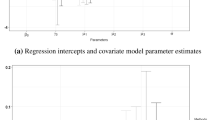Abstract
In this article, we present Bayesian analysis of capture-recapture models for a closed population which allows for heterogeneity of capture probabilities between animals and bait/trap effects. We use a flexible discrete mixture model to account for the heterogeneity and behavioral effects. In addition we present a solid model selection criterion. Through illustrations with a motivating dataset, we demonstrate how Bayesian analysis can be applied in this setting and discuss some major benefits which result, including consideration of informative priors based on historical data.
Similar content being viewed by others
References
Akaike, H. (1973), “Information Theory and an Extension of the Maximum Likelihood Principle,” in Proceedings of the Second International Symposium on Information Theory, eds. B. N. Petrov and F. Csaki, Budapest: Akademiai Kiado, pp. 267–281.
Basu, S., and Ebrahimi, N. (2001), “Bayesian Capture-Recapture Methods for Error Detection and Estimation of Population Size: Heterogeneity and Dependence,” Biometrika, 88, 269–279.
Berger, J. O. (1985), Statistical Decision Theory and Bayesian Analysis (2nd ed.), New York: Springer-Verlag.
Brownie, C., Anderson, D. R., Burnham, K. P., and Robson, D. S. (1985), Statistical Inference From Band Recovery Data: A Handbook (2nd ed.), Washington, DC: U.S. Fish and Wildlife Service Resources, Publication 156.
Castledine, B. (1981), “Bayesian Analysis of Multiple-Recapture Sampling for a Closed Population,” Biometrika, 67, 197–210.
Darroch, J. N. (1958), “The Multiple Recapture Census. I: Estimation of a Closed Population,” Biometrika, 36, 343–359.
Gelfand, A. E., and Ghosh, S. K. (1998), “Model Choice: A Minimum Posterior Loss Approach,” Biometrika, 85, 1–11.
George, E. I., and Robert, C. P. (1992), “Capture-Recapture Estimation via Gibbs Sampling,” Biometrika, 79, 677–683.
Ishwaran, H., and Zarepour, M. (2002), “Dirichlet Prior Sieves in Finite Normal Mixtures,” Statistica Sinica, 12, 941–963.
Jeffreys, H. (1946), “An Invariant Form for the Prior Probability in Estimation Problems,” Proceedings of the Royal Statistical Society, Ser. A, 186, 453–461.
Jolly, G. M. (1965), “Explicit Estimates From Capture-Recapture Data with Both Death and Immigration—Stochastic Model,” Biometrika, 52, 225–247.
McCullagh, P., and Nelder, J. A. (1989), Generalized Linear Models (2nd ed.), New York: Chapman and Hall.
McLachlan, G., and Peel, D. (2000), Finite Mixture Models, New York: Wiley.
Norris, J. L., and Pollock, K. H. (1995), “A Capture-Recapture Model with Heterogeneity and Behavioral Response,” Environmental and Ecological Statistics, 2, 305–313.
— (1996), “Nonparametric MLE Under Two Closed Capture-Recapture Models with Heterogeneity,” Biometrics, 52, 639–649.
Otis, D. L., Burnham, K. P., White, G. C., and Anderson, D. R. (1978), “Statistical Inference From Capture Data on Closed Animal Population,” Wildlife Monographs, 62.
Pledger, S. (2000), “Unified Maximum Likelihood Estimates for Closed Capture-Recapture Models Under Mixtures,” Biometrics, 56, 434–442.
Schwartz, G. (1978), “Estimating the Dimension of a Model,” The Annal of Statistics, 6, 461–464.
Seber, G. A. F. (1965), “A Note on the Multiple-Recapture Census,” Biometrika, 52, 249–259.
Spiegelhalter, D., Thomas, A., Best, N., and Lunn, D. (2001), WinBUGS User Manual (version. 1.4), Cambridge, UK. MRC Biostatistics Unit. Available at http://www.mrc-bsu.cam.ac.uk/bugs.
Spiegelhalter, D. J., Best, N. G., Carlin, B. P., and van der Linde, A. (2002), “Bayesian Measures of Model Complexity and Fit,” (with discussion), Journal of the Royal Statistical Society, Ser. B, 64, 583–639.
Titterington, D. M., Smith, A. F. M., and Makov, U. E. (1985), Statistical Analysis of Finite Mixture Distributions, New York: Wiley.
Author information
Authors and Affiliations
Corresponding author
Rights and permissions
About this article
Cite this article
Ghosh, S.K., Norris, J.L. Bayesian capture-recapture analysis and model selection allowing for heterogeneity and behavioral effects. JABES 10, 35–49 (2005). https://doi.org/10.1198/108571105X28651
Received:
Revised:
Issue Date:
DOI: https://doi.org/10.1198/108571105X28651




